
In baseball, hit by pitch (HBP) is an event in which a batter or his clothing or equipment is struck directly by a pitch from the pitcher; the batter is called a hit batsman (HB). A hit batsman is awarded first base, provided that he made an honest effort to avoid the pitch, although failure to do so is rarely called by an umpire. Being hit by a pitch is often caused by a batter standing too close to, or "crowding", home plate.

Mickey Charles Mantle, nicknamed "the Mick" and "the Commerce Comet", was an American professional baseball player. Mantle played his entire Major League Baseball (MLB) career (1951–1968) with the New York Yankees, primarily as a center fielder. Mantle is regarded by many as being one of the best players and sluggers of all time. He was an American League (AL) Most Valuable Player three times and was inducted into the Baseball Hall of Fame in 1974.

Lynn Nolan Ryan Jr., nicknamed "the Ryan Express", is an American former professional baseball pitcher and sports executive. Over a record 27-year playing career in Major League Baseball (MLB), Ryan pitched for the New York Mets, California Angels, Houston Astros, and Texas Rangers. After his retirement in 1993, Ryan served as chief executive officer (CEO) of the Texas Rangers and an executive advisor to the Houston Astros. He was inducted into the Baseball Hall of Fame in 1999, and is widely considered to be one of the greatest MLB pitchers of all time.
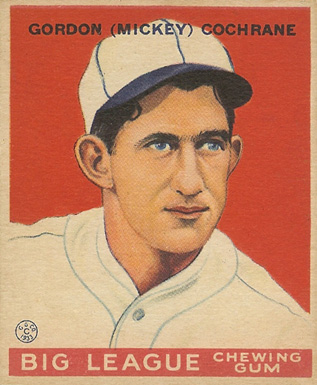
Gordon Stanley "Mickey" Cochrane, nicknamed "Black Mike", was an American professional baseball player, manager and coach. He played in Major League Baseball as a catcher for the Philadelphia Athletics and Detroit Tigers. Cochrane was considered one of the best catchers in baseball history and is a member of the Baseball Hall of Fame. In his first season as manager, he led the Tigers to 101 wins, which was the most for a rookie manager for 27 years.

Warren Edward Spahn was an American professional baseball pitcher who played 21 seasons in Major League Baseball (MLB). A left-handed pitcher, Spahn played in 1942 and then from 1946 until 1965, most notably for the Boston Braves, who became the Milwaukee Braves after the team moved west before the 1953 season. His baseball career was interrupted by his military service in the United States Army during World War II.
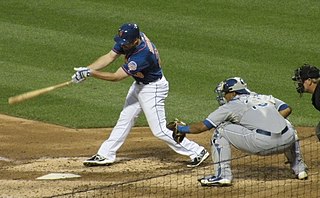
Catcher is a position in baseball and softball. When a batter takes their turn to hit, the catcher crouches behind home plate, in front of the (home) umpire, and receives the ball from the pitcher. In addition to this primary duty, the catcher is also called upon to master many other skills in order to field the position well. The role of the catcher is similar to that of the wicket-keeper in cricket.
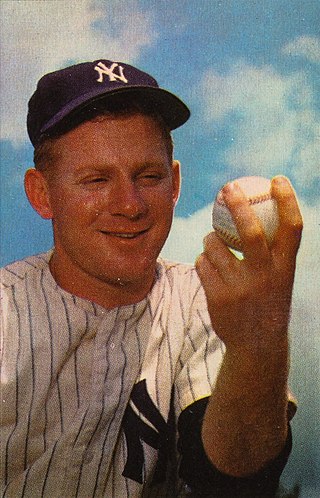
Edward Charles "Whitey" Ford, nicknamed "the Chairman of the Board", was an American professional baseball pitcher who played his entire 16-year Major League Baseball (MLB) career with the New York Yankees. He was a 10-time All-Star and six-time World Series champion. In 1961, he won both the Cy Young Award and World Series Most Valuable Player Award. Ford led the American League (AL) in wins three times and in earned run average twice. He is the Yankees franchise leader in career wins (236), shutouts (45), innings pitched, and games started by a pitcher. Ford was inducted into the Baseball Hall of Fame in 1974.
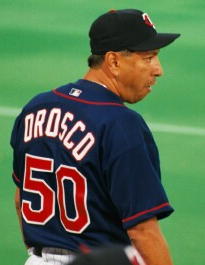
In baseball, a left-handed specialist is a relief pitcher who throws left-handed and specializes in pitching to left-handed batters, weak right-handed batters, and switch-hitters who bat poorly right-handed. Because baseball practices permanent substitution, these pitchers frequently pitch to a very small number of batters in any given game, and rarely pitch to strictly right-handed batters. Most Major League Baseball (MLB) teams have several left-handed pitchers on their rosters, at least one of whom is a left-handed specialist. A left-handed specialist is sometimes called a LOOGY, coined by John Sickels, and may be used pejoratively.

In baseball, a cut fastball or cutter is a type of fastball that breaks toward the pitcher's glove-hand side, as it reaches home plate. This pitch is somewhere between a slider and a four-seam fastball, as it is usually thrown faster than a slider but with more movement than a typical fastball. Some pitchers use a cutter to prevent hitters from expecting their regular fastballs. A common technique for throwing a cutter is to use a four-seam fastball grip with the baseball set slightly off center in the hand. A batter hitting a cutter pitch often achieves only soft contact and an easy out due to the pitch's movement keeping the ball away from the bat's sweet spot. The cutter is typically 2–5 mph slower than a pitcher's four-seam fastball. In 2010, the average pitch classified as a cutter by PITCHf/x thrown by a right-handed pitcher was 88.6 mph; the average two-seamer was 90.97 mph.

Throughout the history of baseball, the rules have frequently changed as the game continues to evolve. A few common rules most professional leagues have in common is that four balls is a base on balls, three strikes is a strikeout, and three outs end a half-inning.

Robert Richard Boyd was an American first baseman in the Negro leagues and Major League Baseball.

Charles Theodore "Chili" Davis is a Jamaican-American former professional baseball player. He played as an outfielder and designated hitter from 1981 to 1999 for the San Francisco Giants (1981–1987), California Angels, Minnesota Twins (1991–1992), Kansas City Royals (1997) and New York Yankees (1998–1999). His first MLB coaching position after his playing career was with the Oakland Athletics from 2012 to 2014. He also coached for the Boston Red Sox, Chicago Cubs and the New York Mets. Davis was a switch-hitter and threw right-handed. He is the first ballplayer born in Jamaica to appear in an MLB game.

In baseball, the lefty-righty switch is a maneuver by which a player who may be at a disadvantage against an opponent of a certain handedness is replaced by a substitute who is better suited for the situation.

Greg Allen Harris is an American former professional baseball pitcher, who played in Major League Baseball (MLB) for 15 years, 1981–1995. Harris pitched in 703 career games, starting 98. He pitched for eight different teams, including the San Diego Padres when they lost the 1984 World Series to the Detroit Tigers in five games.
Pat McMahon is an American former college and professional baseball coach who currently works in the New York Yankees' organization.

The "M&M Boys" were the duo of New York Yankees baseball players Mickey Mantle and Roger Maris, who were teammates from 1960 to 1966. They gained prominence during the 1961 season, when Maris and Mantle, batting third and cleanup (fourth) in the Yankee lineup respectively, both challenged Babe Ruth's 34-year-old single-season record of 60 home runs. The home run lead would change hands between the two teammates numerous times throughout the summer and fueled intense scrutiny of the players by the press. Maris eventually broke the record when he hit his 61st home run on the final day of the season, while Mantle hit 54 before he was forced to pull out of the lineup in September because of an abscessed hip.
Home Run Derby is a 1960 television show that was held at Wrigley Field in Los Angeles pitting the top sluggers of Major League Baseball against each other in nine-inning home run contests. The show was produced and hosted by actor/broadcaster Mark Scott and distributed by Ziv Television Programs.

In baseball, a switch-pitcher is an ambidextrous pitcher who is able to pitch with either the right or left hand from the pitcher's mound.
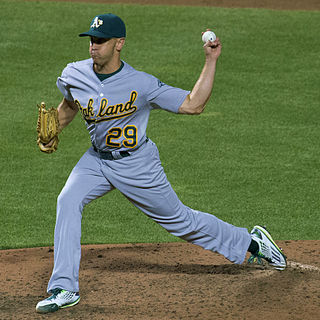
Patrick Michael Venditte Jr. is an American former professional baseball pitcher. He played in Major League Baseball (MLB) for the Oakland Athletics, Toronto Blue Jays, Seattle Mariners, Los Angeles Dodgers, San Francisco Giants, and Miami Marlins. After attending Creighton University, Venditte was drafted by the New York Yankees in 2008. He signed with the Athletics as a free agent before the 2015 season and made his MLB debut that year.
This is an alphabetical list of selected unofficial and specialized terms, phrases, and other jargon used in baseball, along with their definitions, including illustrative examples for many entries.



















